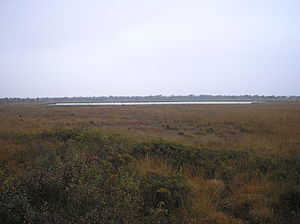Huvenhoopsmoor
|
Huvenhoopsmoor
|
||
|
View over the intact Huvenhoopsmoor to the Huvenhoopssee |
||
| location | Southeast of Gnarrenburg , northwest of Zeven , in the district of Rotenburg in Lower Saxony | |
| surface | 1,373 ha | |
| Identifier | NSG LÜ 247 | |
| WDPA ID | 81972 | |
| Geographical location | 53 ° 22 ' N , 9 ° 6' E | |
|
|
||
| Sea level | from 8 m to 15 m | |
| Setup date | 06/19/1937 | |
| administration | NLWKN | |
The Huvenhoopsmoor is a moor area with a still intact raised moor in northern Lower Saxony . It belongs to the community of Gnarrenburg . The Huvenhoopsmoor was included in the list of 77 excellent National Geotopes in 2006.
history
In the area around Gnarrenburg peat has been extracted for centuries . First of all, peat was cut by the bog colonists in order to make the land arable and to use the strongly decomposed black peat as fuel. In the 19th century, raised bog peat became popular as a fuel in the cities (especially Bremen ) and industrial peat extraction began. Only then did the permanent damage to the moors in the area between Weser and Elbe begin . Part of the Huvenhoopsmoor has been completely spared from drainage and peat removal to this day. As early as the 1960s, the intact remains were separated from the surrounding areas by a watertight sheet pile wall in order to prevent them from drying out in the course of the drainage in the area.
Even today peat is extracted in some areas of the Huvenhoopmoors, but not in the strictly protected intact remainder. Today efforts are being made to regenerate the peated areas. At the end of the 1990s, a “moor adventure trail” was set up, which provides insights into the intact moor residue as well as regeneration areas. There are many indications that nature in the Huvenhoopsmoor is recovering from the massive interventions.
nature
Conservation measures
The 1.5 square kilometer intact remainder is largely open terrain with very few trees and is surrounded by bushes. The raised bog area may not be entered, but it can be seen from an observation stand on the bog adventure trail. In the center is the Huvenhoopssee, one of the last intact raised bog lakes in Lower Saxony with an interesting world of birds , especially duck birds , which can be observed with binoculars from the observation post.
Wildlife
Recently some cranes have been breeding again in the Huvenhoopsmoor . In addition, one finds tree falcon , gray geese , gray shrikes and many duck species. There is also a resettlement program with black grouse that populate the bushy edge of the moor. There are also over 20 types of dragonflies .
The crane migration is particularly spectacular in spring and October. On the way to and from their breeding grounds in Eastern Europe, the cranes rest for a few days in the Huvenhoopsmoor. During this time, the moor is populated by several thousand cranes that feed on harvested fields in the area.
Flora
Last but not least, the intact bog is overgrown with cotton grass . Of course, you will also find the peat moss and sundew typical of bogs here . Many shrubs and dwarf shrubs such as blueberries , mountain ash , bog birch , gagel and aronia, which comes from North America, grow in the bog edge .
Peat extraction and moor protection
Not far from the intact remainder is the Gnarrenburg peat plant, which is still in operation and has even received new mining licenses in recent years. However, the need for peat has changed fundamentally in recent years: While black peat used to be in the foreground, which serves as fuel and forms the basis of raised bogs, white peat is of interest for today's horticultural applications , which is found in raised bogs above black peat is located. To remove peat, the moor is drained, the upper layer of plants is removed and the white peat is cut. The black peat below remains untouched. The water is then dammed up over the peat areas and the moor can regenerate. In this way, peat extraction in the Gnarrenburg area should continue for a few decades.
Web links
- Nature reserve "Huvenhoopsmoor" in the database of the Lower Saxony State Office for Water Management, Coastal and Nature Conservation (NLWKN)
- "Huvenhoopsmoor" nature reserve , leaflet from the Rotenburg district (Wümme) (PDF file, 2.2 MB)
swell
- ↑ Gerfried Caspers: A landscape drowns - The Huvenhoopsmoor near Rotenburg an der Wümme. In: Ernst-Rüdiger Look, Ludger Feldmann (Ed.): Fascination Geology. The important geotopes of Germany , E. Schweizerbart'sche Verlagsbuchhandlung, Stuttgart 2006, ISBN 3-510-65219-3 , p. 22f.
- Information boards for the moor adventure trail in the Huvenhoopsmoor NSG





